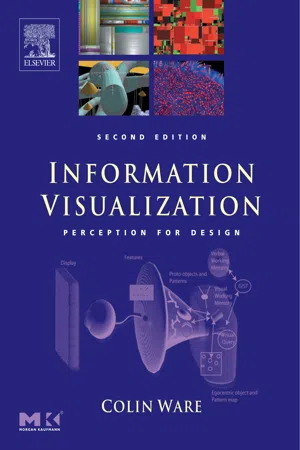
- 486 pages
- English
- PDF
- Available on iOS & Android
About This Book
Information Visualization is the major revision of a classic work on information visualization. This book explores the art and science of why we see objects the way we do. Based on the science of perception and vision, the author presents the key principles at work for a wide range of applications - resulting in visualization of improved clarity, utility, and persuasiveness. This is the first work to use the science of perception to help serious designers and analysts optimize understanding and perception of their data visualizations.
This unique and essential guide to human visual perception and related cognitive principles will enrich courses on information visualization and empower designers to see their way forward. Its updated review of empirical research and interface design examples will do much to accelerate innovation and adoption of information visualization. New to this edition are a new chapter on visual thinking, new sections on face perception and flow visualization, and a much-expanded chapter on color and color sequences.
This book will appeal to interaction designers; graphic designers of all kinds (including web designers); financial analysts; research scientists and engineers; data miners; and managers faced with information-intensive challenges.
*First work to use the science of perception to help serious designers and analysts optimize understanding and perception of their data visualizations.* Major revision of this classic work, with a new chapter on visual thinking, new sections on face perception and flow visualization, and a much expanded chapter on color and color sequences. *New to this edition is the full color treatment throughout, to better display over 400 illustrations.
Frequently asked questions
Information

Table of contents
- Cover
- Contents
- Figure Credits
- Foreword
- Preface
- Chapter 1 Foundation for a Science of Data Visualisation
- Chapter 2 The Environment, Optics, Resolution and the Display
- Chapter 3 Lightness, Brightness, Contrast and Constancy
- Chapter 4 Color
- Chapter 5 Visual Attention and Information that Pops Out
- Chapter 6 Static and Moving Patterns
- Chapter 7 Visual Objects and Data Objects
- Chapter 8 Space Perception and the Display of Data in Space
- Chapter 9 Images, Worlds and Gestures
- Chapter 10 Interacting with Visualizations
- Chapter 11 Thinking with Visualizations
- Appendix A Changing Primaries
- Appendix B CIE Color Measurement System
- Appendix C The Perceptual Evaluation of Visualization Techniques and Systems
- Bibliography
- Subject Index
- Author Index
- About the Author